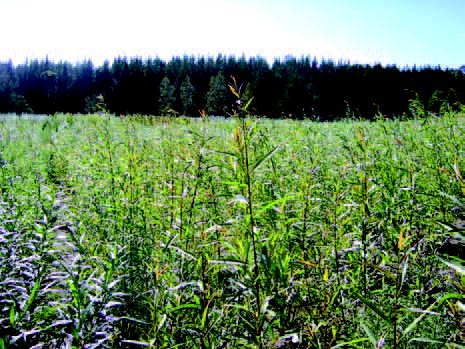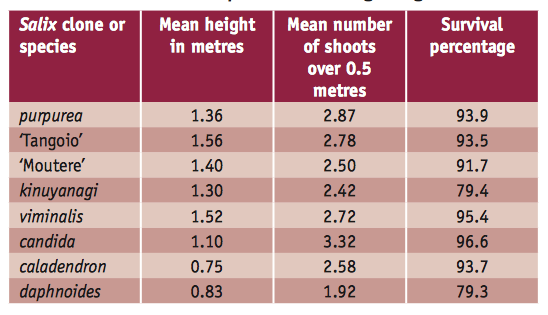Short rotation coppice willow as low carbon bioenergy farming
Ian McIvor, New Zealand Tree Grower November 2007.
Bioenergy is not new. Before the invention of the steam engine and internal combustion engine society was dependent on horsepower of a different kind − the real horsepower. Horses needed biofuel in the form of oats and hay. In 1900 Britain’s 3.5 million horses consumed the annual output of six million hectares, town horses alone consumed up to two million tons of oats and over three million tons of hay. Since the available land in Britain was only 26 million hectares, the only way that Britain could sustain its horse population in 1900 was by cheap imports, since the arable land was needed to feed its human population. In the United States, crops for horses took up 36 million hectares of arable land.

The ecological costs of using horses for transport were reflected in the diseases caused by the huge volume of waste that horses generate. Dried horse droppings produced noxious dust particles, and the manure that did not dry attracted flies which helped transfer diseases to humans. The majority of horse manure was not recycled by farms but rotted on the streets, eventually entering sewers and contaminating natural water sources and contributing to outbreaks of typhoid fever.
The point is, of course, that transport has always come at a cost and has always created pollution, whether the fuel was oil or bioenergy. However horse manure never added to the global atmospheric carbon dioxide.
Why return to bioenergy again?
Bioenergy,or biomass energy, is the use of plants and other biologically derived materials as a source of energy. Bioenergy crops are renewable and remove as much carbon dioxide from the atmosphere as they contribute as a fuel, in contrast to mined oil.
Bioenergy is an international response to global warming from rising atmospheric carbon dioxide levels sourced primarily from the use of fossil fuels. Internationally we are becoming more sophisticated in our use of bioenergy. Technologies have been developed to process a wide range of biomass sources such as plants, oils, and waste gas from landfills, into a variety of forms and uses. Bioenergy and biofuels are topical issues. New Zealand and the world need alternative renewable energy sources. The development of a bioenergy industry in New Zealand will involve the exploring of new biomass feedstocks, designing new technologies to convert biomass to biofuels, and developing the infrastructure to support the use of bioenergy and biofuels. The introduction of dedicated crops for bioenergy will raise issues around appropriate land use and the limited competitiveness of energy crops compared to food crops.
In a number of European countries dedicated woody bioenergy crops are being grown on short-rotations of three to four years, primarily because of the multiple environmental,rural development, and social benefits associated with their production and use. Most projections of global energy use predict that biomass will be a more important component of primary energy sources in the future, and that woody crops, with their low fertiliser requirement and low energy harvesting methods, will be the primary source of biomass.
In addition to combustion and gasification conversion pathways for power and heat production, woody crops represent a uniform, locally available feedstock for the production of liquid fuel, chemicals, and other advanced materials currently derived from petroleum products. The government’s biofuels plan will be phased in from April 2008, with a starting requirement for biofuels to make up 0.53% of fuel sales, rising to 3.4% by 2012. Biofuel sourced from biomass crops will be necessary to reach these targets.
Salix for bioenergy
Willow, poplar and eucalypts have among them some excellent coppice species. The ability of trees to re-sprout has been used world wide since ancient times in agriculture and forestry, to produce fuel, fodder, household articles, shade, snow and wind protection. Today coppicing is used in plantations of woody species, with the main product being biomass for energy and pulp. Short rotation coppicing plantations with selected clones are established with woody stem cuttings, which develop adventitious roots when planted. After the establishment of the root system, repeated harvests of shoots can be made. The original cutting, the shoots and the roots together, form a unit which is commonly referred to as a stool.
A critical aspect of biomass plantations is the sustainability of the system, especially since the ability to withstand repeated harvesting varies widely between different species. In this respect the spacing and rotation harvesting cycle are extremely important factors which have a strong influence both on yield and life expectancy of the stools. Research has shown that willow plantations with Salix viminalis in Sweden reach the optimum production at a spacing of about 15,000 to 20,000 stems per hectare and a rotation cycle of three to five years, whereas poplars usually need wider spacings and longer rotations, as also do some tree formed willows. Most short rotation coppicing systems using willow operate on a three to four-year rotation cycle and a lower planting density.
Short rotation coppicing and the environment
Energy crop plantations can generate local environmental benefits including soil carbon accumulation, increased soil fertility, reduced nutrient leaching, and improved biodiversity. Short rotation coppicing willow plantations have been investigated for wastewater treatment in several European countries.
Research and years of commercial scale applications indicate that willow crops do not decrease soil nutrient levels or have other detrimental impacts on soil properties. The diversity and density of micro-arthropods under willow immediately after planting is similar to that in agricultural fields that are tilled annually, but lower than in undisturbed fallow fields. Four years after planting, however, the density and diversity of soil micro-arthropods under willow are similar to levels in nearby undisturbed fallow fields. Because of the perennial nature of the crop, it is anticipated that these levels will be maintained or increased.
Biomass yields
A field assessment of short rotation coppicing willow and poplar biomass production was done at Aokautere and at Flock House Research Centre by the National Plant Materials Centre between 1977 and 1984 using 25 cm cuttings at variable spacings for a range of clones. These included three Salix matsudana x S. alba clones, S. viminalis Gigantea, S. purpurea ‘Booth’ and ‘Irette’ clones, two poplar clones Flevo and Tasman and Eucalyptus ovata.
Mean yields for one year rotation ranged from 11.2 to 24.6 tonnes per hectare per year and for two year rotation from 7.6 to 27.1 tonnes per hectare per year on five to seven year stools. The upper yields compare very favourably with yields reported recently from Sweden and the US. The planting density ranged from 7,000 to 111,000 stools per hectare. Recommended densities for production short rotation coppicing willow are 12,000 to 15,000 stools per hectare on three year rotations. Yields will vary depending on site, available water and efficiency of establishment.

No further work on short rotation coppicing willow biomass was done in New Zealand until 2005 when MAF’s Sustainable Farming Fund sponsored a trial at Rotokawa near Taupo. This trial was focussed on determining best practices for the establishment and growing of production short rotation coppicing woody crops, particularly willow, on land bordering LakeTaupo. The table indicates growth of the various willows after one growing season. These trials support the vision to establish crops of willow for bioenergy.
Energy farming has the potential to complement other land use activities, such as dairying. Being grown as a crop also provides riparian protection and an option for effluent nutrient management. Other activities are proceeding that will provide a market for these crops. BioJoule Ltd is undertaking research focused on the growth of shrub willow as feedstock for use in commercial bio-refining to produce products derived from cellulose, lignin and hemicellulose, including ethanol. The Rotokawa trial is entering its third growing season and the information gathered and lessons learned will be included in a handbook being written for farmers wanting to grow short rotation coppiced willow bioenergy crops.

While there is no yield data on commercially grown short rotation coppicing crops in New Zealand, the willow yield trial of the 1980s has been complemented by yield trials of short rotation Eucalyptus saligna conducted in the Manawatu region during the 1990s.
The table below shows the potential of short rotation coppice eucalypts (based on all-year-round harvesting in New Zealand. Similar results should be possible for other short rotation coppice systems.
Pests and diseases
Willow species and varieties grown in short rotation coppice as a renewable energy source can be susceptible to significant damage caused by the rust pathogen Melampsora epitea. In Ireland willow is planted in species mixtures to reduce the effect of rust. Mixtures of up to six components can significantly reduce the build up of rust to levels where it has little or no adverse affect on growing plants.
The dry matter yield from a willow mixture was significantly greater than the equivalent mean yield of the components and greater than the best yielding component. This increase can be partially attributed to decreased disease pressures as well as to interactions between components within a mixture. This mixtures concept should also be incorporated into short rotation coppicing development in New Zealand.
Fortunately the shrub willow species favoured for short rotation coppicing are less susceptible to rust and willow sawfly depredations than the tree willows, but best practice should be adopted before the problem arrives.
Land requirements
Short rotation coppicing bioenergy crops will require land in the order of thousands of hectares, and since they are a crop, it needs to be good land, well watered either by rain or irrigation. Based on the yields recorded from field trials of coppiced eucalypts in the Manawatu region over four three-year rotations, the land area to supply a 10 MW base load power station was calculated to be around 2,800 hectares. The sites should be within 50 km of the refinery, and the processing should generate several income streams, not just ethanol biofuel or biomass for electricity generation.
Ian McIvor is a scientist in sustainable land management at HortResearch

 Farm Forestry New Zealand
Farm Forestry New Zealand